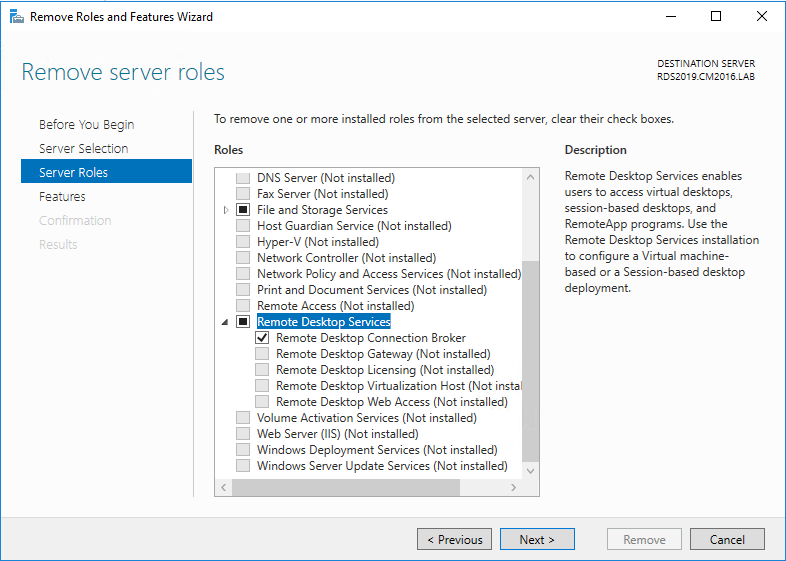- How To Guide Deploying Remote Desktop Services On Windows ..
- Remote Desktop Services Windows Server 2019
- Remote Desktop Windows Server 2019 Activation
Mar 31, 2020 Most notably, 2019 gave rise to a vulnerability known as BlueKeep that could allow cybercriminals to remotely take over a connected PC that's not properly patched. Further, hackers continually use. Feb 11, 2021 Following this article, one can install and configure Remote Desktop Services on a Windows Server 2019 and publish the RDP app to access a server or a desktop as per need on the remote desktop web app portal. Add Remote Desktop Services Role Add Server to RD Licenses and RD gateway Install public CA certificate to each role of RDS.
To enable Remote Desktop, take the following steps:
Using Server Manager
Step 1 : Open Server Manager from the Start menu. And select Local Server.
Step 2 : In the Properties section, click the highlighted Remote Desktop setting.
Step 3 : In the System Properties window, select the Allow remote connections to this computer option.
Step 4 : The Remote Desktop Connection dialog box informs you that the Remote Desktop firewall exception will be enabled. Click OK to close it.
Step 5 : To add Remote Desktop users, click the Select Users… button.
Step 6 : In the Remote Desktop Users window, click the Add button to add users. Select users or groups from your AD DS. When you have finished adding Remote Desktop users, click OK to close the Remote Desktop Users window.
Step 7 : Again, click OK to close the System Properties window.
Using Server Configuration
Step 1 : Type Sconfig.cmd, and then press ENTER. The Server Configuration tool interface opens.
Step 2 : Enter 7 as a selected option and press Enter.
Step 3 : To enable Remote Desktop, enter E and press Enter.
Step 4 : Enter 1 and press Enter for more secure access.
Step 5 : In the Remote Desktop dialog box, click OK to confirm Remote Desktop enabling
In some cases, when connecting to remote computers/RDS server via RDP, users may encounter an “An internal error has occurred” error. This error may appear due to various reasons related to both the settings of the RDP/RDS server and the client (Windows settings, or settings in the Remote Desktop Connection window).
The error “An internal error has occurred” usually appears after user credentials is entered in the mstsc.exe window or immediately after clicking the Connect button.
Since there may be several causes for this RDP error, try to use the following tips one by one until you find a solution that helps you.
The easiest way to fix the problem is to reboot the remote RDP/RDS server and your computer from which you are establishing RDP connection. If you cannot restart the server right now, you should try to restart the Remote Desktop Service. You can do this with the following commands running in the elevated cmd.exe:
Or you can restart Remote Desktop Services from the services.msc console.
Open the properties of your RDP connection in Remote Desktop Connection windows and make sure the ‘Reconnect if the connection is dropped‘ option is enabled on the Experience tab
READ ALSOHow to Allow Saved Credentials for RDP Connection?Next, try to recreate the RDP certificate:
How To Guide Deploying Remote Desktop Services On Windows ..
- Open local computer certificates MMC snap-in, by running the certlm.msc command;
- Go to the following certificate section: Remote Desktop > Certificates;
- Right click your self-signed certificate RDP cert and delete it (if there are several RDP certs, remove them all);
- Restart the Remote Desktop Services as described above.
You can try to change the maximum outstanding connections limit on your RDP server via the registry. Set the following registry value via regedit.exe:
Or with PowerShell:

Dct car. Check the current MTU size oy your Windows with the command:
If the current MTU size for your network interface is equal or more than 1500 (default Windows value), reduce it by using the command:
Try to change some Group Policy setting using the Local GPO editor (gpedit.msc) or domain Group Policy Management Console (gpmc.msc).
- Disable UDP protocol for RDP connection on clent side: Computer configuration > Administrative Templates > Windows Components > Remote Desktop Services > Remote Desktop Connection Client > Turn Off UDP on Client = Enabled;
- Enable FIPS compliant algorithms: Computer configuration > Windows Settings > Security Settings > Local Policies > Security Options > System cryptography: Use FIPS compliant algorithms for encryption, hashing, and signing = Enabled;
- Disable the hardware encoding and enforced AVC:444 mode on the RDP server side: Computer configuration > Administrative Templates > Windows Components > Remote Desktop Services > Remote Desktop Session Host > Remote Session Environment > Prioritize H.264/AVC 444 Graphics mode for Remote Desktop Connection = Disabled;
- Try to change the RDP security level to RDP mode (use the policy ‘Require use of specific security layer for remote connections’ according to the
After changing the policy settings, you need to apply them on the client and server using the
READ ALSOHow to Enable Remote Desktop (RDP) Remotely?
Now check that your RDP client connects without errors.
 Author
Author Recent PostsCyril KardashevskyI enjoy technology and developing websites. Since 2012 I'm running a few of my own websites, and share useful content on gadgets, PC administration and website promotion.Latest posts by Cyril Kardashevsky (see all)
Recent PostsCyril KardashevskyI enjoy technology and developing websites. Since 2012 I'm running a few of my own websites, and share useful content on gadgets, PC administration and website promotion.Latest posts by Cyril Kardashevsky (see all)Remote Desktop Services Windows Server 2019
Remote Desktop Windows Server 2019 Activation
